Whooping Cranes Venture into Broward County
Whooping Cranes Venture into Broward County
|
Administrator
|
The new year got off to an exciting start. There were surprises, not all of them pleasant.
First, our local Bald Eagles have hatched out at least one chick, now visible to many enthralled nest-watchers.. You may remember (as related in this earlier post) that in early November our son-in-law in Illinois suffered serious injuries to both legs in a fall from a tree stand while hunting deer in North Carolina. He was transported back home to Illinois and required extensive surgery. Now he is wheelchair bound but healing well and should be walking soon. One of his close relatives in the Miami area died suddenly during the first week of January and since he is unable to travel we planned to represent his family at the wake and funeral service. On Saturday, January 5 my friend and neighbor Scott, who regularly walks in our local wetlands area, Tweeted me with a photo taken by his daughter of a white crane, at the northern end of our local south Florida birding patch. On first glance I thought it might be an albino Sandhill Crane, but then realized that it was a juvenile Whooping Crane. The eBird data base contains no historical records of Whooping Crane sightings in either Broward County or Miami-Dade. The bird was in an area in which groups of off-road vehicle drivers assemble on weekend nights and conduct races. I was concerned that the crane could be disturbed. Scott was unavailable and Mary Lou and I had obligations that kept us from going out into the patch, so I posted the sighting on the Tropical Audubon Society Bird Board with a request that someone come out to monitor and help protect the crane. Several birders responded, and some of the ORV riders told them that they had been seeing TWO of the cranes in the area just north of our patch since December 22! The next morning we got out before sunrise and walked about a mile and a half, all the way north out of Miramar into the City of Pembroke Pines. After taking a few steps across the city limits I sighted two white dots in a wet prairie about a half mile away. We had to detour along a city street to avoid entering private land, but sure enough, we found the two Whooping Cranes. 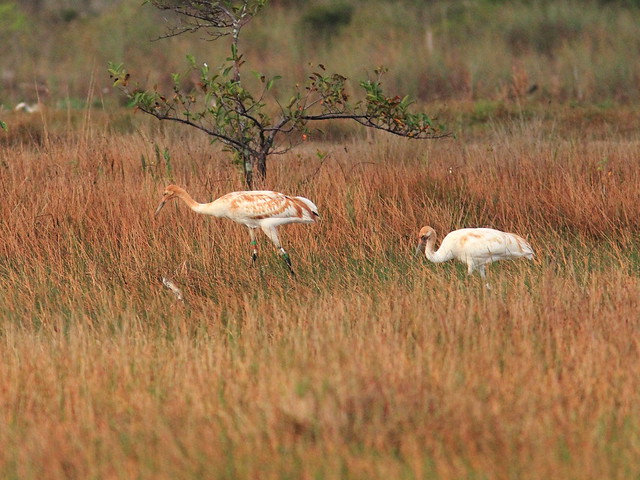 We learned from the website of the WHOOPING CRANE EASTERN PARTNERSHIP (WCEP) that these two first year Whooping Cranes (# 2012-13 and 2012-15) were among the six "Direct Autumn Release" (DAR) birds that migrated without the assistance of an ultralight aircraft. (See VIDEO and additional information at the end of this post). The six cranes, numbered 12 through 17, are identified by the arrangement of colored bands and transmitters on their left and right legs respectively. Cranes # 12 13 15 16 and 17 migrated south in record time. According to WCEP, they departed from the Horicon National Wildlife Refuge in Wisconsin on 31 October. Satellite information indicated roost locations in Lawrence County, Indiana, on 31 October, then in Chester County, South Carolina, on 2 and 3 November where all five were also visually confirmed. Next they were located at Cape Romain National Wildlife Refuge, Charleston County, South Carolina, on 4 November, and in Glynn County, Georgia on 5 November. Remarkably, in six days they had flown about 1200 miles unassisted, from Wisconsin to Clay County, Florida, by 6 November. They moved to Manatee County, Florida, on 7 November and into Everglades National Park, Monroe County, Florida, on 8 November and in Hendry County, Florida, on 9 November. Cranes # 12, 16 and 17 remained in Hendry County, Florida, at least through January 4, 2013 but they were no longer together. On 28 December, # 12 was reported as having a possible leg injury. The remaining crane #14 began migration with Sandhill Cranes from the Horicon National Wildlife Refuge more than three weeks behind the other five, on 23 November. Only 17 days later on 9 December, Crane # 14 was reported with sandhill cranes in Volusia County, Florida, where he remains. These two cranes # 13 and 15 moved from their Hendry County location to Broward County, Florida, on 22 December. Crane # 15, the one first photographed by my neighbor Scott is a male named Cypress. His band color pattern from top to bottom: left leg has a White/Green transmitter with antenna, and right leg has Green/Red/White bands: 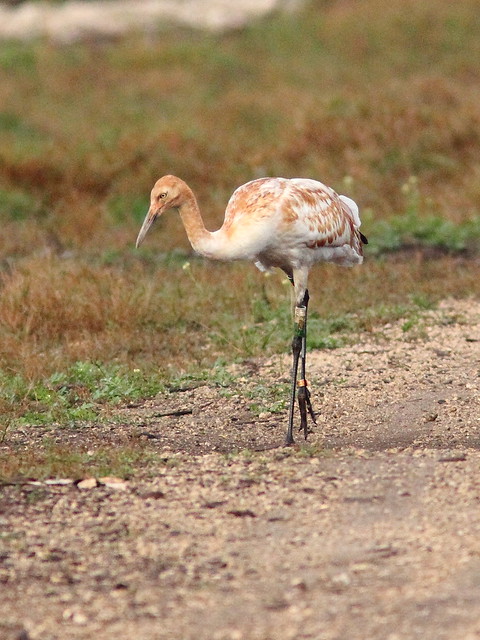 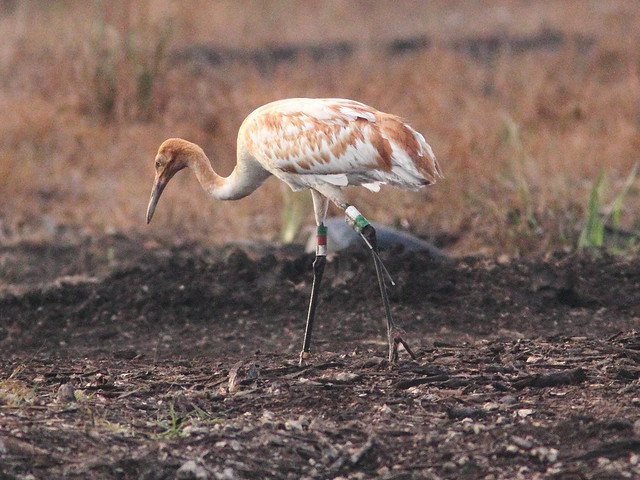 The other is Crane # 13, a female named Tussock. Her band color pattern from top to bottom: left leg has a Red/White transmitter with antenna, and right leg has a White/Green transmitter with antenna:  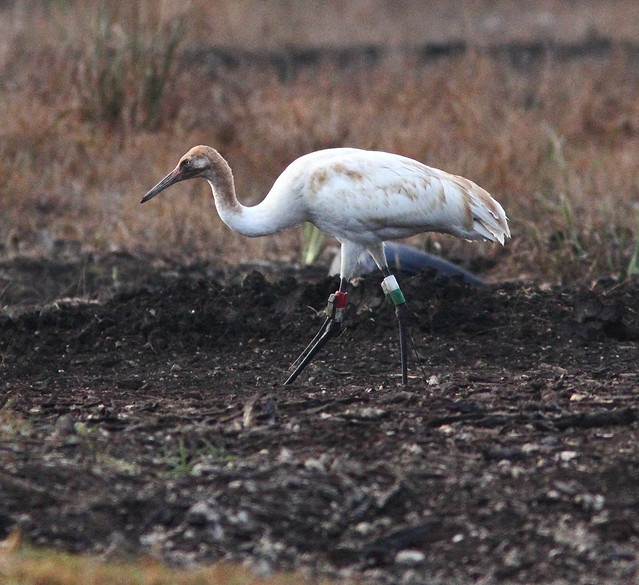 I hoped to personally document their presence on our patch, so on Monday Mary Lou and I again went out before sunrise and walked northward the entire length of the patch. No cranes! She was not interested in slogging the muddy trails and returned home, while I hiked an additional three miles along several paths that border the wetlands and lake. Not finding the cranes, I headed for home. Just after entering our patch I ran into Brian Monk, another birder who was also searching for the cranes. I casually scanned the open areas with binoculars, and suddenly spotted one of the cranes. It was nearly a quarter of a mile away (actually 0.21 mile according to Google Earth), so my photo that documents the sighting is quite fuzzy. This is the male: 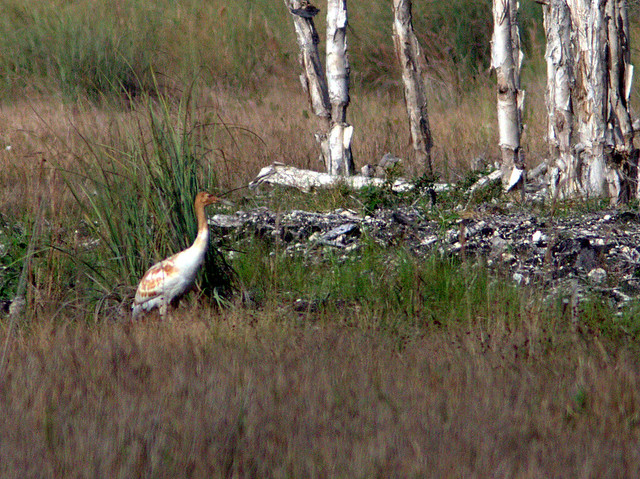 As we continued south along the lake, Brian saw a white speck on the opposite shore, about 0.43 mile away. He gets credit for my opportunity to photograph the female: 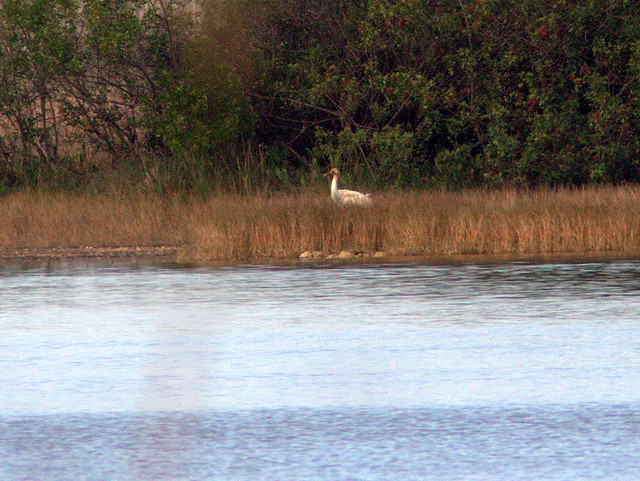 Brian and I were exploring an area where I saw both Swamp and Savannah Sparrows last week when Mary Lou called me at about 11:30 AM with news that our daughter in Illinois had fallen while carrying their Christmas tree down the stairs and had fractured bones in her ankle. Her husband is wheelchair-bound and she would need surgery. We were needed there to help them care for themselves and our two 7- and 8-year old granddaughters (not to mention two huge Tibetan Mastiffs and two large salt-water fish tanks). I rushed home and quickly made reservations. We packed and departed on a plane to Chicago at 3:30 PM, a quick transition from sub-tropical 84 degrees (F) to 12 degrees and blowing snow! Here they are, on Facebook. His open reductions required a metal plate, 10 screws, two pins and a cadaver bone transplant; She needed 13 screws, one metal plate, two pins, a washer and a wire, between them enough to keep a hardware store in business! <div class="separator" style="clear: both; text-align: center;">  </div> </div>By the way, Whooping Cranes in this population are not "countable" for listing purposes as officially established in the American Birding Association (ABA) area. Of course, I like to watch pre-season exhibition football, basketball and baseball, and I enjoy the games even though they don't "count." <div class="separator" style="clear: both; text-align: center;"> </div> Best viewed full-screen size. <u> </u> <iframe allowfullscreen="allowfullscreen" frameborder="0" height="315" src="http://www.youtube.com/embed/FeKMkfJOlco" width="420"></iframe> <u> </u> <u>Whooping Crane Reintroduction</u> <u> </u> The Whooping Crane Eastern Partnership (WCEP), of which the International Crane Foundation (ICF) is a founding member. presently operates two projects to restore a migratory Whooping Crane population in the eastern USA. The Ultralight-led Migration Project that began in 2001 utilizes eggs from captive breeding centers that are hatched at the Patuxent Wildlife Research Center in Maryland. The young cranes are later transferred to Wisconsin and trained to follow ultralight craft. After making their first migration to St. Marks National Wildlife Refuge on Florida's west coast, they find their way back to Wisconsin alone and continue to migrate back and forth unassisted. A second method, called the Direct Autumn Release (DAR), was started in 2005. These cranes are raised by the ICF using attendants dressed in crane costumes. Kept from human contact, they are housed with adult Whooping Cranes to assure that they imprint properly. Before fledging, they are transferred to Wisconsin and finally to the release point at Horicon National Wildlife Refuge. They learn to fly south by following the older cranes. Radio and satellite telemetry allow them to be tracked by ICF and US Fish & Wildlife Service For more information, visit http://www.savingcranes.org/into-the-wild.html
Ken Schneider
Web site: http://rosyfinch.com Blog: http://rosy-finch.blogspot.com Photos: <http://flickr.com/photos/rosyfinch> |
«
Return to Local Habitat and Inhabitants-- Photos and reports
|
1 view|%1 views
| Free forum by Nabble | Edit this page |

